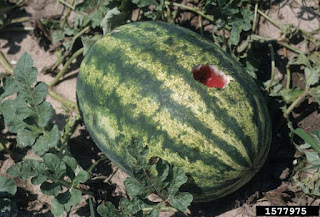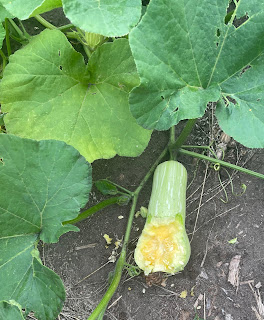I
After a few days of heat, things were unseasonably cool over the last week. Things are more seasonable now, and things will continue to be on the cool side. Read on for updates on identifying wildlife damage, turning over high tunnels, tomato issues, and garlic.
Vertebrate pests
Now is the time of year we get calls about deer, racoons, and birds doing the most heartbreaking damage they do – taking an exceptionally rude single bite out of stuff we are ready to harvest.
Deterring animals once they have tasted how good your crops are is very difficult – it takes a lot of scare to overpower the memory of how delicious fresh sweet corn or ripe watermelon is. Noting which animals are doing the most damage can help you have your scares in place before animals find your crops next year.
If deciding what can still be harvested, remember to take food safety into consideration – it is best to leave a harvest buffer around areas where there is evidence of animal activity.
Racoon Damage
Raccoon damage in watermelon. Photo: Whitney Cranshaw, Colorado State University, Bugwood.org
Racoons are most likely to damage watermelon and sweet corn. In watermelon, they make one hole and use their hands to dig out the flesh. In sweet corn, they yank the ear down towards the ground, strip open the husk, and eat kernels. Look for their footprints to confirm their presence.
Rodent Damage
Rodents damage often has sharp, clipped edges, compared to the scraped gouges that deer make. Chipmunks are a common tomato feeder in urban and suburban areas. Groundhogs also feed on a variety of crops, look for their burrows to help diagnose suspected issues.
Scabbed over rodent feeding in pumpkin. Photo: Marissa Schuh, UMN Extension.
Bird Damage
Crows are most likely to feed on watermelons and occasionally tomatoes. Crows tend to make one hole and feed a little bit, then hop over to another plant and repeat the process. One crow can do serious damage.
Crows are most likely to feed on watermelons and occasionally tomatoes. Crows tend to make one hole and feed a little bit, then hop over to another plant and repeat the process. One crow can do serious damage.
Crows peck one hole and dig shallowly in the melon. Gerald Holmes, Strawberry Center, Cal Poly San Luis Obispo, Bugwood.org
In sweet corn, red winged blackbird is the most likely bird you’ll see. The messily peel open husks and will feed on the top half of the ear. They may also leaves droppings behind.
Deer damage
This time of year, deer will feed on all kinds of stuff. You can tell their feeding apart from other animals because they are kind of messy eaters – they have flat teeth and no upper incisors, so their feeding lacks distinct, sharp edges. Their feeding usually involves some tearing because they can’t clip stems and leaves the way rodents can. In sweet corn, deer scrape kernels of ears with their lower teeth. They will eat cucurbits, sometimes making a big mess as they dig in to feed on the seeds.
Note that just because you have seen deer in the field doesn’t mean they are the primary damage doer, confirm by taking a look at the damage you are seeing.

Crop Updates
Leafy greens: Growers who plan to grow winter crops in tunnels such as spinach and other cold hardy greens should start to plan now for high tunnel turnover. Ideally, this would include a soil test so that you can make amendments in the time between pulling your current summer crop, and planting the next one. Johnnys has an excellent chart showing when you should plant various crops relative to the "Persephone period" when daylengths drop below 10 hours per day, and plants basically go dormant. If you like to learn by listening, check out this episode of the Vegetable Beet podcast about winter greens. The hosts had a very helpful discussion about varieties that may help you choose what to grow.
Garlic: Curing is ongoing. If you are done curing and starting to think about which bulbs to plants next year, remember we had quite a few reports of aster yellows from garlic growers this year. Take time to sort through your garlic and look for bulbs infected with Aster Yellows. If you suspect you have it, you can still eat your infected garlic, but do not save and re-plant it. More about aster yellows here.
If you are gearing up for fall garlic plantings, the Sustainable Farming Association has a directory of local garlic sellers who have tested negative for Garlic Bloat Nematode. Now that your garlic has cured, sort through it and look for bulbs infected with Aster Yellows. Farmers around the state are seeing AY in their garlic. If you suspect you have it, you can still eat your infected garlic, but do not save and re-plant it. More about garlic aster yellows.
Tomato: Tomato harvest is ongoing. If you have some fruits not fit for sale and want to investigate the causes, see this article for a rundown of common tomato fruit issues in Minnesota.
We are getting reports of long-lived soilborne disease in hoophouses. There are a couple of diseases hoop house tomatoes are especially prone to, and in hard-to-rotate spaces like hoophouses, these diseases will show up by dint of bad luck. If you suspect you have a soilborne disease, get a sample in for diagnosis. While this is a pain and we recommend it often in this newsletter, only with diagnosis of your farms specific disease, or even specific strain of a disease, can you do effective cultural and chemical controls.
Vine crops: Now is a good time to remove cucumber and zucchini / summer squash plants that are winding down, as they can be disease sources for other cucurbits.
Deer damage
This time of year, deer will feed on all kinds of stuff. You can tell their feeding apart from other animals because they are kind of messy eaters – they have flat teeth and no upper incisors, so their feeding lacks distinct, sharp edges. Their feeding usually involves some tearing because they can’t clip stems and leaves the way rodents can. In sweet corn, deer scrape kernels of ears with their lower teeth. They will eat cucurbits, sometimes making a big mess as they dig in to feed on the seeds.
Note that just because you have seen deer in the field doesn’t mean they are the primary damage doer, confirm by taking a look at the damage you are seeing.
Deer feeding on an immature butternut squash. Photo: Marissa Schuh, UMN Extension.
Crop Updates
Leafy greens: Growers who plan to grow winter crops in tunnels such as spinach and other cold hardy greens should start to plan now for high tunnel turnover. Ideally, this would include a soil test so that you can make amendments in the time between pulling your current summer crop, and planting the next one. Johnnys has an excellent chart showing when you should plant various crops relative to the "Persephone period" when daylengths drop below 10 hours per day, and plants basically go dormant. If you like to learn by listening, check out this episode of the Vegetable Beet podcast about winter greens. The hosts had a very helpful discussion about varieties that may help you choose what to grow.
Garlic: Curing is ongoing. If you are done curing and starting to think about which bulbs to plants next year, remember we had quite a few reports of aster yellows from garlic growers this year. Take time to sort through your garlic and look for bulbs infected with Aster Yellows. If you suspect you have it, you can still eat your infected garlic, but do not save and re-plant it. More about aster yellows here.
If you are gearing up for fall garlic plantings, the Sustainable Farming Association has a directory of local garlic sellers who have tested negative for Garlic Bloat Nematode. Now that your garlic has cured, sort through it and look for bulbs infected with Aster Yellows. Farmers around the state are seeing AY in their garlic. If you suspect you have it, you can still eat your infected garlic, but do not save and re-plant it. More about garlic aster yellows.
Tomato: Tomato harvest is ongoing. If you have some fruits not fit for sale and want to investigate the causes, see this article for a rundown of common tomato fruit issues in Minnesota.
We are getting reports of long-lived soilborne disease in hoophouses. There are a couple of diseases hoop house tomatoes are especially prone to, and in hard-to-rotate spaces like hoophouses, these diseases will show up by dint of bad luck. If you suspect you have a soilborne disease, get a sample in for diagnosis. While this is a pain and we recommend it often in this newsletter, only with diagnosis of your farms specific disease, or even specific strain of a disease, can you do effective cultural and chemical controls.
Vine crops: Now is a good time to remove cucumber and zucchini / summer squash plants that are winding down, as they can be disease sources for other cucurbits.
.JPG)
Comments
Post a Comment